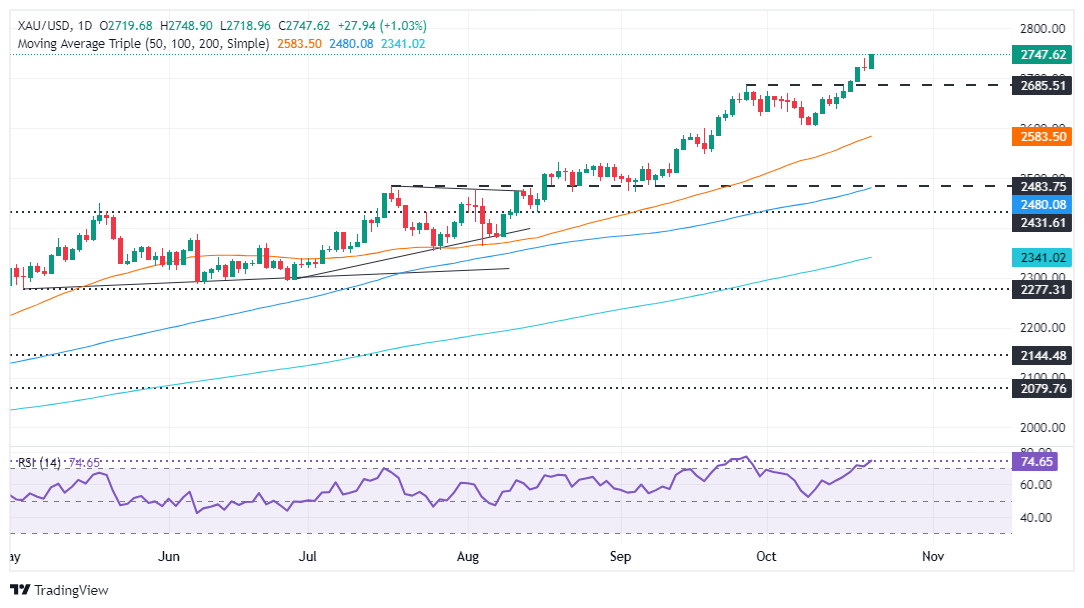- Gold price surges to an all-time high, nearing the $2,750 mark, supported by geopolitical tensions and expectations of further Fed rate cuts.
- Despite rising US Treasury yields, risk aversion and fears of a Trump presidency drive safe-haven demand for Gold.
- Traders are pricing in 42 bps of Fed rate cuts by year-end with 89.6% odds of a 25 bps cut at the November meeting.
Gold prices extended their gains for the fifth day out of the last six and reached an all-time high (ATH) at $2,748, just shy of the psychological $2,750 mark. Geopolitical tensions and expectations that the Federal Reserve (Fed) would continue to lower borrowing costs are tailwinds for the yellow metal. Therefore, XAU/USD trades at $2,744, gaining almost 1%.
Risk aversion keeps the non-yielding metal underpinned, ignoring soaring US Treasury yields. Since the Fed cut rates by 50 basis points (bps) at the September 18 meeting, the US 10-year Treasury note has risen 62 bps to 4.20%, indicating that traders are pricing in a less dovish Fed.
Fears of a Donald Trump presidency have pushed the golden metal higher. The former President has stated that he would impose tariffs and restrict undocumented immigration.
US bonds were sold off on Monday, which, according to TD Securities analysts, “was partly driven by the prediction markets’ pricing in higher odds of a Trump victory.”
Aside from this, Fed officials crossed the wires. San Francisco Fed President Mary Daly said she supports further easing and hasn’t seen any reason not to continue lowering rates. Later, Kansas City Fed President Jeffrey Schmid took a more cautious stance, stating his preference to avoid outsized rate cuts and noting that the labor market is experiencing normalization rather than deterioration.
Traders are now pricing in 42 basis points of cuts by year-end, indicating a less than certain chance that the Fed will make 25 basis point cuts at each of its coming two meetings.
Meanwhile, tensions in the Middle East remain high as Israel prepares to retaliate against Iran following the 200-missile raid.
Despite that, the Fed is heavily expected to lower interest rates by 25 basis points at the November meeting. Odds remained at 89.6%, according to CME FedWatch Tool data.
Daily digest market movers: Gold price rises, ignoring higher US yields
- On Thursday, US Initial Jobless Claims for the week ending October 19 are foreseen rising from 241K to 242K.
- October’s S&P Global Manufacturing PMI is expected to improve from 47.3 to 47.5. The Services PMI for the same period is estimated to dip from 55.2 to 55.
- Data from the Chicago Board of Trade, based on the December Fed funds rate futures contract, indicates that investors estimate 47 basis points (bps) of Fed easing by the end of the year, which is slightly lower compared to a week ago.
XAU/USD technical outlook: Gold price climbs toward $2,750
Gold price ignored the formation of a Gravestone Doji candlestick pattern on Monday and extended its rally to new record highs, just shy of $2,750. Momentum shows buyers remain in charge, as depicted by the Relative Strength Index (RSI). Even though the RSI has turned overbought, its most extreme reading, following a steeper advance, would be 80. Therefore, further Bullion upside is seen.
If XAU/USD clears today’s high at $2,748, the next stop would be $2,750, followed by $2,800.
Conversely, if XAU/USD retreats from record highs below $2,700, it could pave the way for a pullback. The first support would be the October 17 high at $2,696, followed by the October 4 high at $2,670.
Fed FAQs
Monetary policy in the US is shaped by the Federal Reserve (Fed). The Fed has two mandates: to achieve price stability and foster full employment. Its primary tool to achieve these goals is by adjusting interest rates. When prices are rising too quickly and inflation is above the Fed’s 2% target, it raises interest rates, increasing borrowing costs throughout the economy. This results in a stronger US Dollar (USD) as it makes the US a more attractive place for international investors to park their money. When inflation falls below 2% or the Unemployment Rate is too high, the Fed may lower interest rates to encourage borrowing, which weighs on the Greenback.
The Federal Reserve (Fed) holds eight policy meetings a year, where the Federal Open Market Committee (FOMC) assesses economic conditions and makes monetary policy decisions. The FOMC is attended by twelve Fed officials – the seven members of the Board of Governors, the president of the Federal Reserve Bank of New York, and four of the remaining eleven regional Reserve Bank presidents, who serve one-year terms on a rotating basis.
In extreme situations, the Federal Reserve may resort to a policy named Quantitative Easing (QE). QE is the process by which the Fed substantially increases the flow of credit in a stuck financial system. It is a non-standard policy measure used during crises or when inflation is extremely low. It was the Fed’s weapon of choice during the Great Financial Crisis in 2008. It involves the Fed printing more Dollars and using them to buy high grade bonds from financial institutions. QE usually weakens the US Dollar.
Quantitative tightening (QT) is the reverse process of QE, whereby the Federal Reserve stops buying bonds from financial institutions and does not reinvest the principal from the bonds it holds maturing, to purchase new bonds. It is usually positive for the value of the US Dollar.

